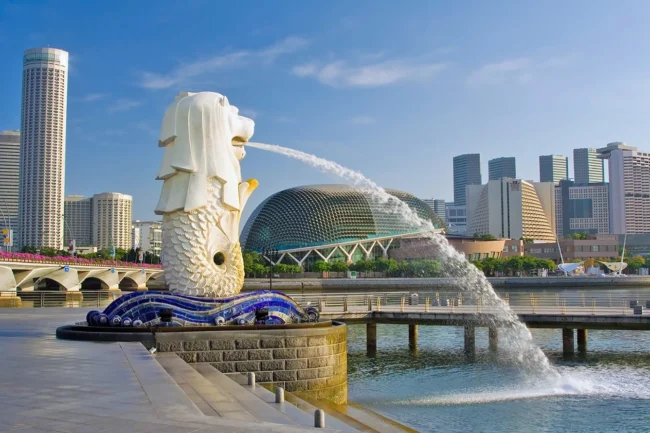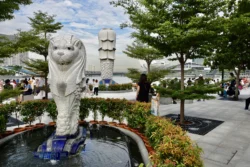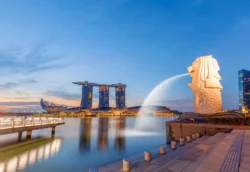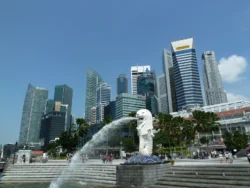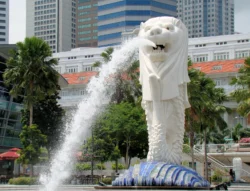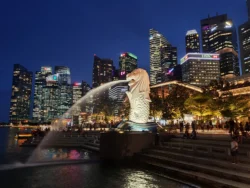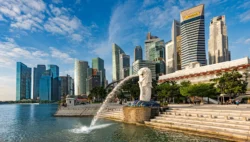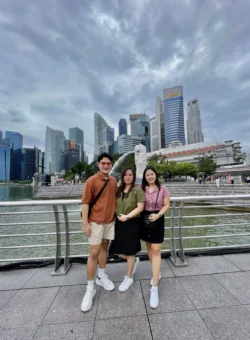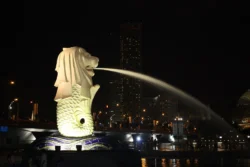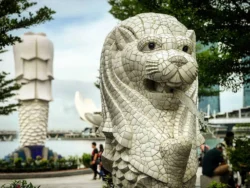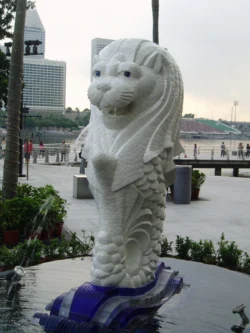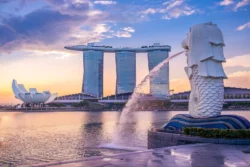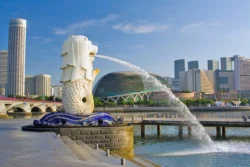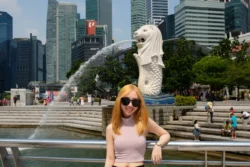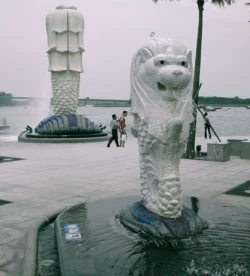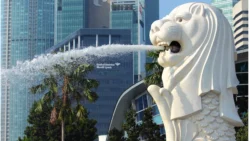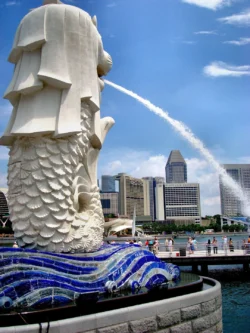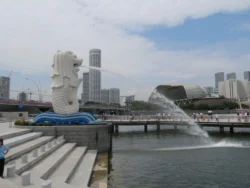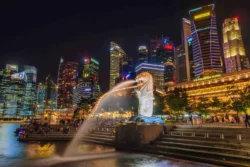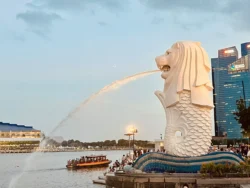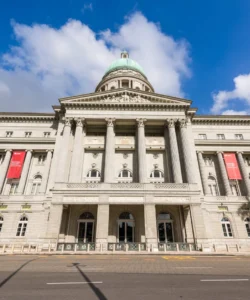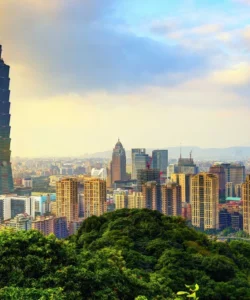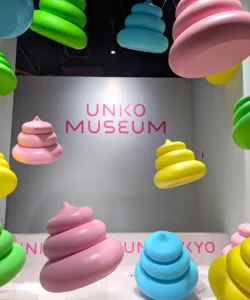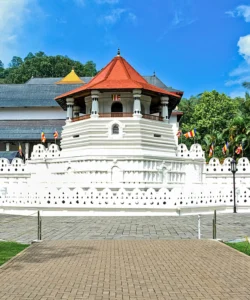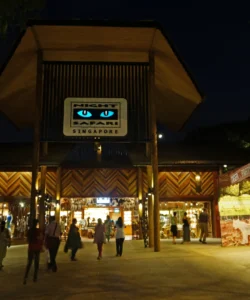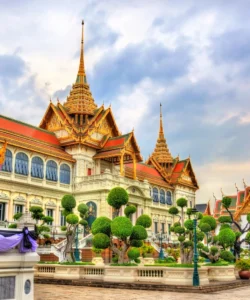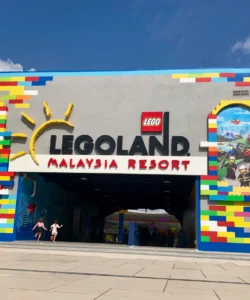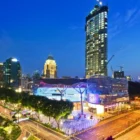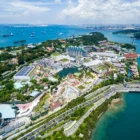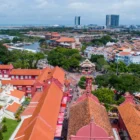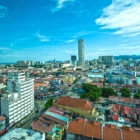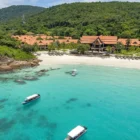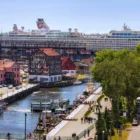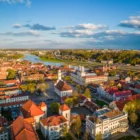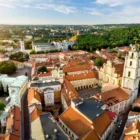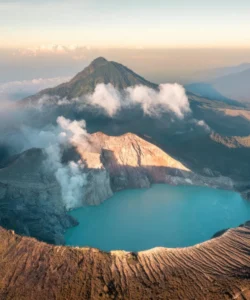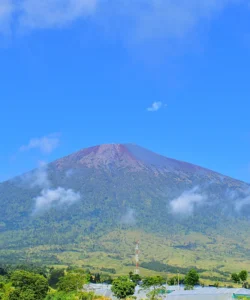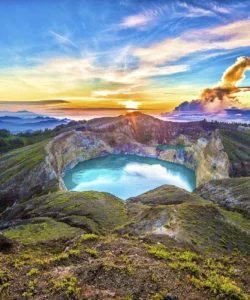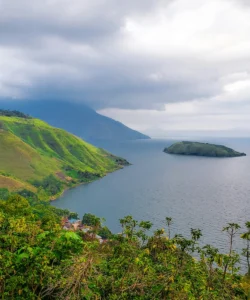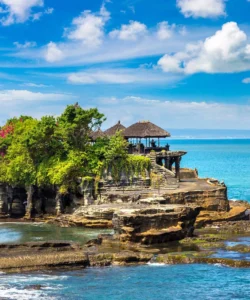Merlion Park is Singapore’s iconic landmark, home to the mythical Merlion statue that serves as the nation’s official mascot and a powerful symbol of its history and identity. Located at the mouth of the Singapore River, overlooking Marina Bay, it offers quintessential photo opportunities and stunning views of the city’s modern skyline.
Name: Merlion Park
Address: 1 Fullerton Road, Singapore 049213.
It’s strategically located in the heart of Singapore’s Central Business District, on the waterfront of Marina Bay.
How to Get There:
Merlion Park is highly accessible and usually a must-visit spot on any Singapore itinerary:
- By MRT (Mass Rapid Transit): The most convenient way is to take the East-West Line (Green Line) or North-South Line (Red Line) to Raffles Place MRT Station (EW14/NS26). From there, it’s a short 5-10 minute walk along the Singapore River to the park.
- By Bus: Numerous public bus routes stop within walking distance of Merlion Park, particularly along Fullerton Road and Collyer Quay.
- By Taxi/Ride-Sharing (Grab, Gojek, Tada): Taxis and ride-sharing services are readily available throughout Singapore and can drop you off directly at the park.
- By Foot: Merlion Park is easily walkable from other major attractions in Marina Bay, such as Marina Bay Sands, the Esplanade, and the Singapore Flyer, via the waterfront promenade and Jubilee Bridge.
- Singapore River Cruise: For a scenic approach, you can take a Singapore River Cruise. Many bumboats offer hop-on, hop-off services, and Merlion Park is a common stop, allowing you to arrive by water.
Landscape and Architecture:
Merlion Park is less about grand architecture in itself and more about the iconic statue set against a stunning urban backdrop.
- The Merlion Statue: The centerpiece is the 8.6-meter (28-foot) tall original Merlion statue, weighing 70 tonnes, which continuously spouts water from its mouth into Marina Bay. Designed by Alec Frederick Fraser-Brunner and sculpted by Lim Nang Seng, it combines the head of a lion (representing “Singapura” or “Lion City,” Singapore’s original name) and the body of a fish (symbolizing Singapore’s origins as a fishing village, “Temasek”).
- The Merlion Cub: Located a short distance from the main Merlion, there is a smaller, 2-meter tall Merlion cub statue, which also spouts water. This provides another photo opportunity and ensures the main Merlion isn’t always overcrowded.
- Waterfront Promenade: The park itself is a well-maintained open-air promenade along the waterfront, offering ample space for visitors to stroll, relax, and take photos.
- Panoramic Views: The “landscape” of Merlion Park is greatly enhanced by the panoramic views it offers. From here, you get unobstructed vistas of Singapore’s most famous landmarks across Marina Bay, including:
- Marina Bay Sands Resort: With its three towers and SkyPark.
- ArtScience Museum: The striking lotus-shaped building.
- Esplanade – Theatres on the Bay: The distinctive “durian” shaped cultural center.
- Singapore Flyer: The towering observation wheel.
- Helix Bridge: The architecturally unique pedestrian bridge.
- Jubilee Bridge: A pedestrian bridge that connects Merlion Park to the Esplanade and other parts of Marina Bay, offering excellent viewpoints for photography, especially at sunset.
What Makes It Famous:
- National Symbol of Singapore: The Merlion statue is the official mascot and national personification of Singapore. Its image is widely used in tourism, branding, and national identity, making it instantly recognizable globally.
- Iconic Photo Opportunity: It is perhaps the most famous and essential photo stop for any visitor to Singapore. The unique pose of “catching” the water spouted by the Merlion is a classic tourist shot.
- Gateway to Marina Bay: Merlion Park is perfectly situated to offer one of the best vantage points for viewing the entire Marina Bay skyline, especially at night when the buildings are illuminated, and the Spectra light and water show at Marina Bay Sands takes place (visible from the park).
- Historical Significance: The Merlion symbolizes Singapore’s dual origins as a humble fishing village (fish body) and its legendary founding as the “Lion City” (lion head), intertwining myth and history.
- Free Admission: Unlike many other major attractions in Singapore, Merlion Park is free to enter, making it accessible to all visitors regardless of budget.
- Central and Accessible Location: Its prime location in the city center and excellent connectivity make it an easy and convenient landmark to visit.
Differences from Some Other Wonders:
- Symbolic Mascot as Main Attraction: While other wonders might feature statues (Batu Caves’ Lord Murugan), the Merlion is a mythical creature specifically created as a national mascot for tourism and national identity, making it a unique national personification.
- Architectural Simplicity vs. Complex Structures: Unlike the elaborate, multi-faceted architecture of Marina Bay Sands, Gardens by the Bay, or the Petronas Twin Towers, Merlion Park is relatively simple in its built environment. Its “wonder” is derived from the iconic stature of the Merlion itself and the magnificent urban panorama it overlooks, rather than complex building design.
- Open, Public Space: It is primarily an open-air public park, accessible 24/7, without the ticketed entry or controlled environments of theme parks, museums, or even other large attractions like the Singapore Flyer.
- Historical Symbolism over Modern Function: While surrounded by modern marvels, the Merlion itself is a symbol rooted in Singapore’s historical narrative and folklore, whereas attractions like Changi Airport or Marina Bay Sands are famous for their cutting-edge modern function and luxury.
- Photo Op Hub: While all tourist attractions are photo-worthy, Merlion Park’s fundamental appeal for many is its status as the quintessential spot for an iconic “I was here” photo with the Merlion and the Singapore skyline, making it a prime photography destination.
